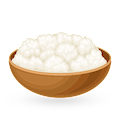MAIN INGREDIENTS
While the traditional version couples only two elements, shortcrust pastry or pâte brisée and juicy mirabelle plums, modern varieties of this classic occasionally place the plums on a bed of pastry cream or creamy custards. Before baking, the tart is sprinkled with powdered sugar (alternatively, the top can be drizzled with mirabelle brandy), and it is then caramelized under a broiler or with a blowtorch.
This autumnal French dessert is often associated with the regions of Lorraine and Alsace, where mirabelle plums are traditionally grown. Because their season is very short, they are a prized ingredient in the French cuisine.
MAIN INGREDIENTS
A decadent version of the classic apple pie, tarte Tatin consists of sliced apples seasoned with butter, sugar, and cinnamon, topped with a buttery pie crust pastry, and baked until the apples become golden and syrupy. The whole cake is then inverted upside-down on a serving platter.
The name of this dessert honors the Tatin sisters, the owners of a restaurant near the city of Orléans who invented the recipe in the early 1900s. However, the cake gained huge popularity when the famous Maxim's Restaurant put it on their menu.
MOST ICONIC Tarte tatin
View moreMAIN INGREDIENTS
Flan pâtissier, also known as flan parisién, is a tart consisting of a pastry shell filled with creamy vanilla custard, all together baked until puffed and golden brown. It is similar to the Portuguese pastel de nata or British custard tart but bigger, less buttery, and less flaky.
The recipes for flan pâtissier vary from patisserie to patisserie, but the base is most often shortcrust or puff pastry, and the custard is made with whole milk, heavy cream, cornstarch, and eggs, with the addition of vanilla. Nowadays, vanilla is sometimes replaced with other flavors, like chocolate, coconut, or seasonal fruits.
MAIN INGREDIENTS
This French classic hails from Normandy, a region famous not only for apples but also for its Calvados apple liqueur, both of which are essential ingredients of tarte Normande and make the perfect match for the delicately sweet almond frangipane cream filling, while the base is made with pâte brisée or shortcrust pastry.
Norman apple tart is typically served with a dollop of crème fraîche on the side, and it is best enjoyed while still warm.
Originating from the Limousin area in France and dating back to at least the mid-1800s, clafoutis is a traditional, crustless French flan, tart, or a type of thick pancake typically consisting of layers of batter and fruit. Its name stems from the French word clafir, meaning to fill.
The flan is traditionally topped with pitted black cherries (although some insist that the cherries should be left unpitted), which lend their rich flavor to the clafoutis as it bakes. It is typically served warm, dusted with a hefty dose of powdered sugar, and sometimes with a dollop of cream on the side.
MAIN INGREDIENTS
Tarte aux brimbelles is a traditional tart that's especially popular in Vosges and Belfort. The pastry dough is made with a combination of flour, butter, sugar, salt, egg yolks, and cold water, while the filling consists of wild blueberries, eggs, sugar, crème fraîche, and either crumbled cookies or semolina.
The dough is covered with plastic wrap and chilled. After an hour, it's rolled out and the blueberries are spread on top. The tart is baked for twenty minutes. A mixture of sugar, eggs, and crème fraîche is poured over the blueberries and the tart is baked for another twenty minutes before serving.
MAIN INGREDIENTS
Tarte à l'oignon is a fragrant, savory onion tart from the Alsace region in France. Essentially, it is an open-face pie that is filled with a rich and flavorful custard of eggs, bacon, and onions. Although it is a cousin to the famous quiche Lorraine, it is not as deep as traditional quiches.
The most popular story about the origin of the onion tart says that it was a baked good with which the bakers would test the heat of the ovens, depending on the time it took to bake it. If the tart was baked in a certain amount of time, that meant that the oven was hot enough for bread to be baked in it.
MAIN INGREDIENTS
Hailing from the natural regions of Thiérache and l'Avesnois, tarte au maroilles is a French tart that features cubes or slices of the renowned Maroilles cheese, a soft cow's milk cheese that is distinguished by a nutty and tangy flavor and a rather pungent smell.
The tart is traditionally prepared with a base of shortcrust pastry or pâte brisée, while the filling usually consists of Maroilles cheese and a combination of crème fraîche, butter, eggs, salt, and pepper. Once assembled, the dish is typically baked until the cheese-based filling has turned gooey, golden brown, and bubbly.
MAIN INGREDIENTS
Tarte aux pralines, or praline tart, is a traditional dessert that hails from the Lyon region. It is celebrated for its vibrant pink color and sweet, nutty flavor. The tart consists of a buttery, flaky pastry crust, typically made from a shortcrust pastry (pâte sucrée), filled with a mixture of crushed pink pralines and heavy cream.
To prepare the pastry crust, you mix flour, sugar, and butter to form a dough, which is then chilled, rolled out, and fitted into a tart pan. The crust is blind-baked until golden. For the praline filling, pink pralines are crushed into small pieces and heated with heavy cream until melted and combined.
MAIN INGREDIENTS
The tarte Bourdaloue, also known as pear almond tart, is a classic French pastry created in the late 19th century. Named after Bourdaloue Street in Paris, where its inventor was based, the tart typically consists of poached pear halves placed on a shortcrust pastry filled with frangipane or almond cream.
The dessert has developed variations such as poached fruits on rice or semolina pudding. This tart showcases the rich flavors of pears and the creamy texture of almond filling, often enjoyed as a delectable treat in French cuisine.
TasteAtlas food rankings are based on the ratings of the TasteAtlas audience, with a series of mechanisms that recognize real users and that ignore bot, nationalist or local patriotic ratings, and give additional value to the ratings of users that the system recognizes as knowledgeable. TasteAtlas Rankings should not be seen as the final global conclusion about food. Their purpose is to promote excellent local foods, instill pride in traditional dishes, and arouse curiosity about dishes you haven’t tried.









